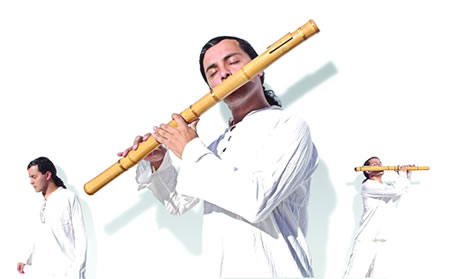
World Flutes Master
Peace web theme set courtesy of Crystal Cloud Graphics web set icon
Crystal Cloud Graphics
Crystal Cloud Graphics


Cuidemos
el Medio Ambiente
el Medio Ambiente

comprar

Dangjeok (traverse flute)
The tang-jok or dangjeok is played horizontally and slightly smaller than the chung'gum. It is similar to the sogum in its size and due to this similarity it is not easy to distinguish it from the sogum, in terms of method of playing structure and use. Thus it has been confused with the sogum and often identified with each other. In specific, they are distinguished only by the number of holes which the tang-jok has the total seven holes: one blowpipe and six finger holes, whereas the sogum has the total eight holes: one blowpipe and seven finger holes.
The tang-jok has been used since the Koryo dynasty and the sogum from Shilla with the taegum and chung'gum. The ambiguity of identifying these instruments seemed to be traced back to the middle of the Chosen dynasty. The origin of the sogum was unknown and it was often identified with the tang-jok. The tang-jok is modified as seven ofinger holes during the 1950s, but the is largely so gum using more than the tang-jok.
Dangjeok is a wind instrument that gives offa clear and bright sound, and has one and a half octave short range according to the music book akhakgwebeom. But it was remodelled into a folk danjeok to enhance its pitch and range to resemble those of daegeum.
The tang-jok or dangjeok is played horizontally and slightly smaller than the chung'gum. It is similar to the sogum in its size and due to this similarity it is not easy to distinguish it from the sogum, in terms of method of playing structure and use. Thus it has been confused with the sogum and often identified with each other. In specific, they are distinguished only by the number of holes which the tang-jok has the total seven holes: one blowpipe and six finger holes, whereas the sogum has the total eight holes: one blowpipe and seven finger holes.
The tang-jok has been used since the Koryo dynasty and the sogum from Shilla with the taegum and chung'gum. The ambiguity of identifying these instruments seemed to be traced back to the middle of the Chosen dynasty. The origin of the sogum was unknown and it was often identified with the tang-jok. The tang-jok is modified as seven ofinger holes during the 1950s, but the is largely so gum using more than the tang-jok.
Dangjeok is a wind instrument that gives offa clear and bright sound, and has one and a half octave short range according to the music book akhakgwebeom. But it was remodelled into a folk danjeok to enhance its pitch and range to resemble those of daegeum.










